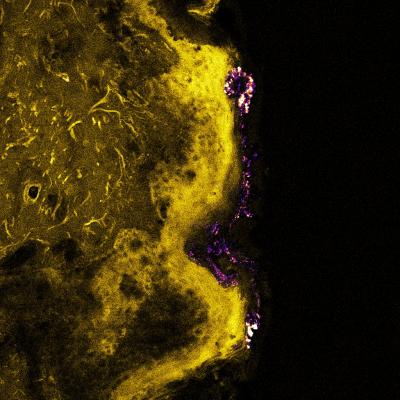In order to study the toxic effects on skin by zinc oxide nanoparticles, the commonly used ingredient in sunscreen products, a team of researchers from Switzerland and Australia has devised an optical method to quantitatively examine the zinc oxide nanoparticle concentration level at various skin depths.
 Overlay of the confocal/multiphoton image of the excised human skin. Yellow color represents skin autofluorescence excited by 405 nm; Purple color represents zinc oxide nanoparticle distribution in skin (stratum corneum) excited by 770 nm, with collagen-induced faint SHG signals in the dermal layer. (Credit: Biomedical Optics Express)
Overlay of the confocal/multiphoton image of the excised human skin. Yellow color represents skin autofluorescence excited by 405 nm; Purple color represents zinc oxide nanoparticle distribution in skin (stratum corneum) excited by 770 nm, with collagen-induced faint SHG signals in the dermal layer. (Credit: Biomedical Optics Express)
Zinc oxide nanoparticles demonstrate high optical absorption in the ultraviolet A and ultraviolet B range and high transparency in the visible light range when integrated into lotions, making it a suitable ingredient for sunscreen cosmetics. However, the demonstration of the toxicity of the zinc oxide nanoparticles on some kinds of human cells prompted the research team to study the impact of the nanomaterial on the skin.
During the research, the team discovered that the zinc oxide nanoparticles were not able to infiltrate below the topmost layer of the cells when exposed to pieces of excised skin. The team reported its findings in the Biomedical Optics Express, an open access journal of the Optical Society. The findings pave the way for extending research in live patients.
The research team’s method is based on the characterization of the nanomaterial’s optical properties. For the study, the team utilized a nonlinear optical microscopy that uses a short-pulse laser light to illuminate the sample and records the resulting return signal. The team rubbed a zinc oxide nanoparticle formulation onto patches of the skin for five minutes and kept them for eight hours at the body temperature and finally washed them off. Preliminary results showed that the nanoparticles were not able to enter below the outermost skin layer or the stratum corneum. According to the team, the novel optical characterization can be a handy tool for potential non-invasive in vivo investigations.